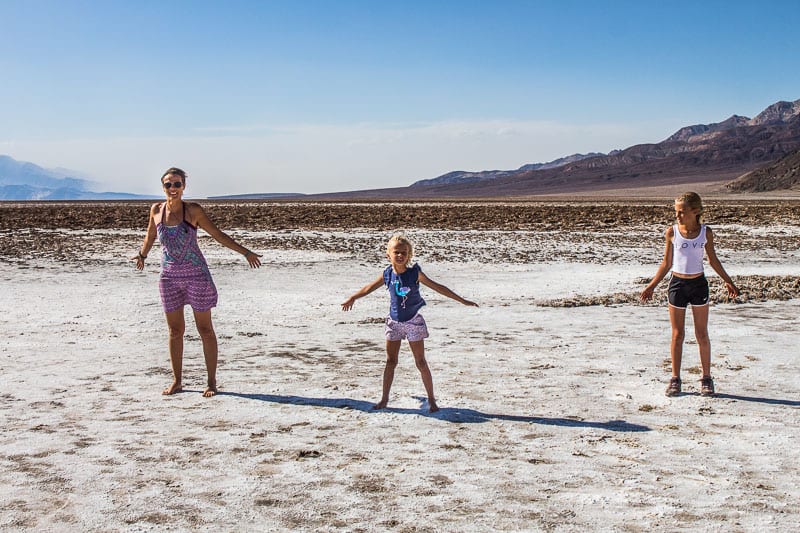This post may contain affiliate links. We may receive a small commission, at no cost to you, if you make a purchase. Read Disclosure.
You’ve probably already heard of Death Valley and it’s extreme accolades – the lowest, hottest, and driest place in North America, the largest national park in the United States, and the film set for Star Wars.
It’s unsurprising that it was used as a backdrop for sci-fi movies, it’s probably the only place on Earth that looks far from Earth-like. It boldly expresses itself in extreme landscapes: scorching salt flats, shifting sand dunes, colorful Badlands and wind-sculpted curves.
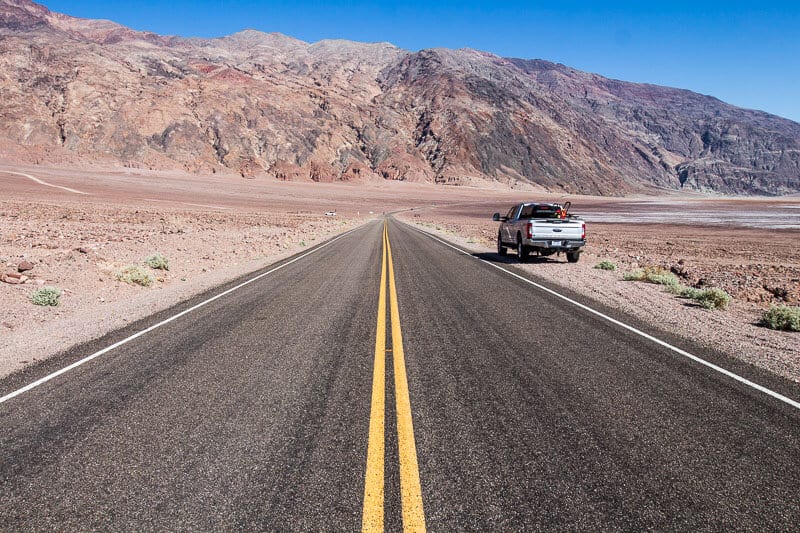
At first glance, Death Valley may seem stark, unforgiving, and a vast expanse of wasteland, but linger a little longer and you’ll discover there are plenty of things to do in Death Valley National Park other than reenacting Return of the Jedi. Behind the impressive geological formations, wildflowers burst into color, bighorn sheep scale rugged canyons, and the night skies remind you how small we are in the great expanse of the universe.
Whether you’re looking for a hiking trail to scale, or want to experience the quiet and desolate Badwater Basin, Death Valley is a place that welcomes the curious, adventurous, and lover of all things extreme.
What is Death Valley famous for?
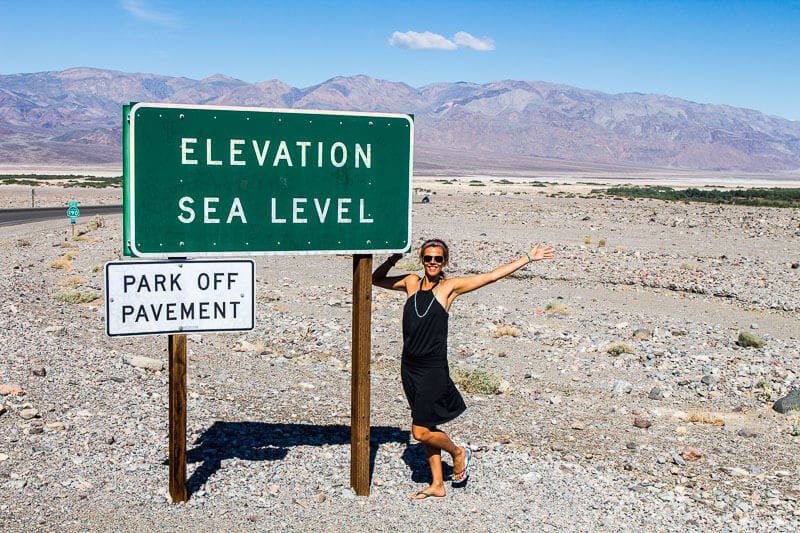
Death Valley National Park is the hottest, driest, and lowest National Park in the USA. Standing on the cliff face (282 ft. high) overlooking Badwater Basin is a white plaque with huge capitals denoting SEA LEVEL.
Below that point is the Badwater Basin, the lowest part of North America. The elevation at Badwater Basin is 282 feet below sea level. Death Valley also has the highest temperature ever recorded 134 degree Fahrenheit (57 degree Celsius) on July 10, 1913.
I’m surprised we haven’t seen higher recorded since then, but, 2016 and 2017 have claimed the hottest average temperatures in Death Valley Park history. In July of 2021, the highest recorded temperature was 130 degrees Fahrenheit (54.4°C).
Death Valley is sandwiched by two mountain ranges – and you are heading deep into a bowl here. Any upcoming earthquake has the potential to make this valley a little lower and a little hotter.

I don’t know why we think nature has finished her creation. It’s always moving and changing, so subtly as it has for millions of years. We barely notice the progress to more exquisite beauty but it’s there.
It was not that hot when we visited, but possibly the windiest. It did a good job of nearly knocking us off our feet, but at least it cooled things down a little. The hottest, driest, and lowest part of the continent didn’t stop wowing and surprising us for the remainder of our stay.
It was definitely the perfect way to finish five months in the desert and transition into the green forest world of Northern California and the Pacific Northwest.
Things to do in Death Valley National Park
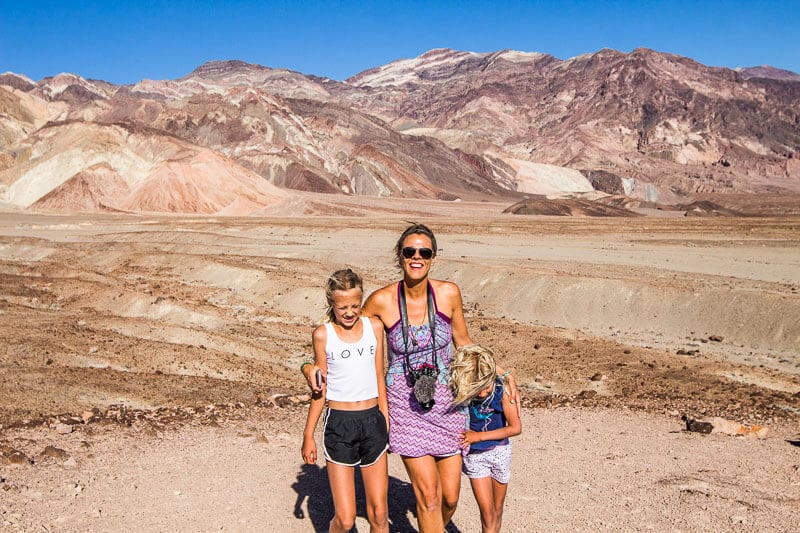
Death Valley is an easy national park to explore. Despite being so famous, it doesn’t have hordes of people, and doesn’t require much other than a few footsteps from your car to the viewpoint. Really all that is required of you is to open your eyes and admire the views. Its beauty is startling.
If you want to do some hiking, there are some trails in Death Valley, but you want to be extra cautious if you are visiting in the hot summer months. It is not wise to hike after 10am and to only hike during cooler temperatures – many signs around the park will remind you of this.
Here are some of the things we enjoyed doing:
1. Watch the sunrise or sunset at Zabriskie Point
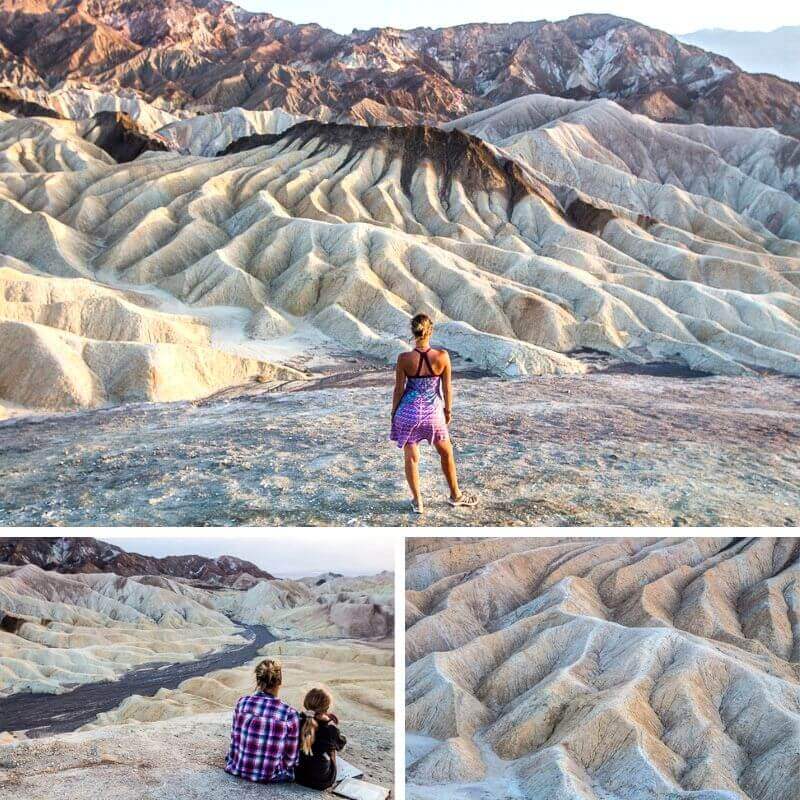
If you only have time to make one stop on your visit to Death Valley, then make it to Zabriskie Point. It is one of the most surreal landscapes I have ever seen.
Ripples of white, yellow, mauve, pink, and chocolate sand dunes frozen in time stretch out in front of you with a purple sandy river running through it and the snow-capped Panamint Mountains range in the background. You can even see the salt flats down in the valley below.
The colors, shapes, and textures are simply breathtaking and mind-blowing. Perhaps we’ll invent a new word to express that. Let’s call it The Zabriskie.
The ranger told us it was best at sunrise. Lonely Planet had a photo that showed a Death Valley sunset from here so we followed the travel bible – it was extraordinary at sunset.

I do think sunrise at Zabriskie Point would be worth doing as well. We visited about two hours after sunrise the next day and it gave us another beautiful perspective. This time we could see the mountains and salt flats as the sun was shining on them.
Sunrise was just a little too early for us to get there with the kids (5:30am). Either way, put this on your itinerary.
2. Experience the Badwater Basin
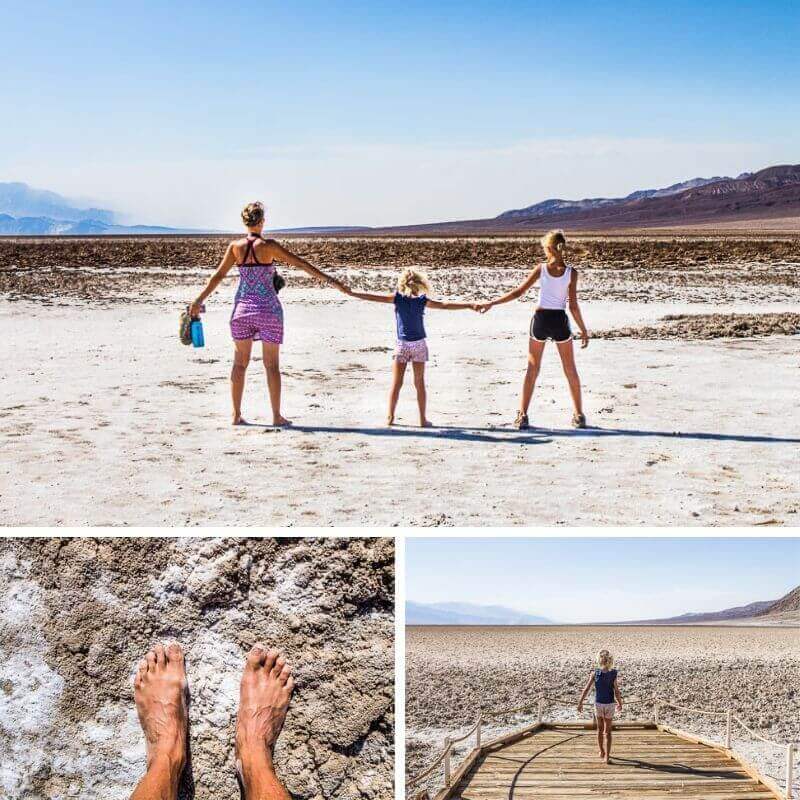
As mentioned, Badwater Basin is the lowest point in North America, and is must-do on your first visit! This is where you can walk out on the salt flats and see the hexagonal honeycomb shapes.
I don’t think we visited at the right time, or walked out far enough to see those, but it was still an incredible place to explore and walk bare feet on – although by far the windiest place we visited in Death Valley! But we did witness devils golf course – an immense area of rock salt eroded by wind and rain into jagged spires!
Badwater Death Valley consists of a small natural pool of undrinkable water next to the gravel road in a sink, and the accumulated salt crystals of the surrounding basin make it undrinkable, thus giving it the name.
Adjacent to the pool, where water is not always present at the surface, repeated freeze–thaw and evaporation cycles gradually push the thin salt crust into hexagonal honeycomb shapes.
As this area gets less than two inches of rain annually and no water can flow out of the basin, the water evaporates leaving behind mineral deposits that cover the basin like a salty dusting of snow.

Badwater Basin is centrally located in the National Park and very popular, and the parking lot fills quickly. Be sure to follow the warnings about hiking during the extreme temperatures of summer, so go early morning and bring lots of water!
3. Admire the views from Dante’s View
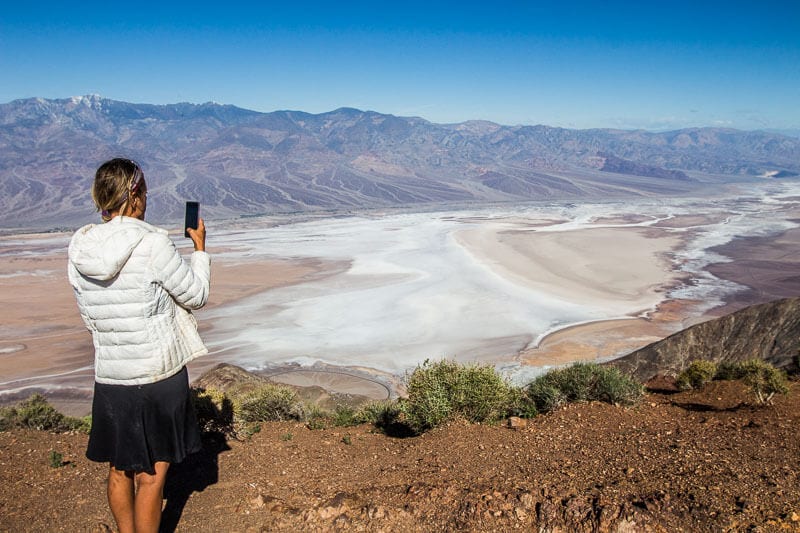
Dante’s View is a little off the beaten path, but totally worth it. It’s a paved road the entire way although the last section contains steep switchbacks and is not fit for long RVs. There are parking bays to unhook and leave your trailers if needed. As the road climbed the mountain, the stark desert landscape turned a little lush.
Dante’s View will give you the BEST bird’s eye view of Death Valley. You really don’t want to miss it. You’ll get the swirling whites and muted browns of the salt basin deep in the valley that stretches for miles. It’s like nothing you’ve ever seen before, and is a Death Valley must-see!
It is way cooler up at Dante’s View too – we had to burst out the jacket from under the car seat. It was a welcome relief from the desert heat. If you visit Death Valley National Park in the winter, be sure to pack your scarves and beanies.
4. Drive the scenic Artist’s Drive

Artists Drive Death Valley is one of the most unique scenic drives I’ve ever experienced. I felt like it’s where they got the inspiration for the Cars Ride at Disneyland. At one point we were on a narrow section of the Death Valley dirt road driving around the foothills of the mountains. The mountains rose steeply up on another side of us, dwarfing even our F250.
This one-way paved road is called the Artist Drive for a reason, the mountain faces look like someone had thrown splashes of paint all over them, prompting the naming of one section to be the artist’s palette.
Now we’d seen enough color in Southern Utah to question the validity of the name of this drive before we went on it, but we can definitely verify that it has earned that title. We saw most colors in Utah, but rarely so many shades of blue on the rocks.
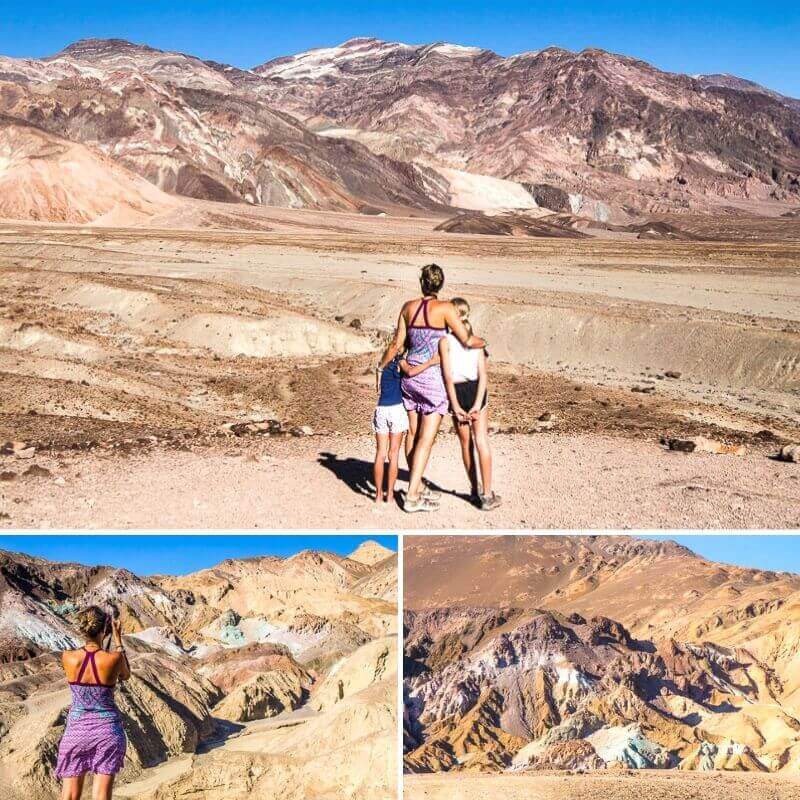
There are two sections on this 9-mile Death Valley National Park scenic drive you can jump out at to look more closely at the palettes of color.
We were SO lucky to have arrived the day after they opened this drive. Apparently, it had been closed for years!! As it was all new, the road was pristine dark black which just made the landscape pop even more.
I was so grateful that our trip to Death Valley had been delayed for a couple of months, otherwise, we would have missed this. What is the saying, God’s delays are not God’s denials? Trust in what the delays will bring you.
5. Take on the Golden Canyon Hike
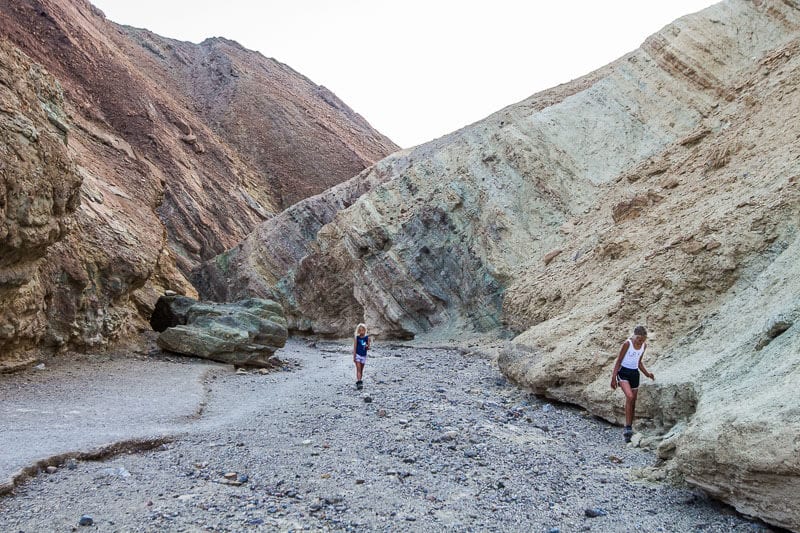
We had a stuff up when it came to hiking the Golden Canyon trail. We’ve been great at training the girls since they were born to be responsible travelers – that is pack their own bags, dress, pack snacks, etc. If they forget then they manage boredom or hunger and won’t forget the next time.
Usually, we’re good at checking them though. We didn’t when we jumped in the car for our afternoon of exploring Death Valley NP. Savannah somehow thought it was good to explore the hottest place in the world with no shoes!!! It worked fine at the salt flats – even better to walk barefoot – and we weren’t expecting to hike anywhere.
Then we stumbled upon Golden Canyon, and with time on our side decided to check it out. A 3-mile return rocky path was no match for bare feet.
We found a pair of Kalyra’s muddy boots in the car and put them on her feet. They kept falling off until we thought of rolling down the tops of the boots. It helped them stay on her feet but it wasn’t so comfortable for her. We plowed through the walk, but only a short way in before turning around and ending her torture.
The Golden Canyon is BEAUTIFUL and one of the best hikes in Death Valley! You can also combine it with the Gower Gulch and Badlands Loop.
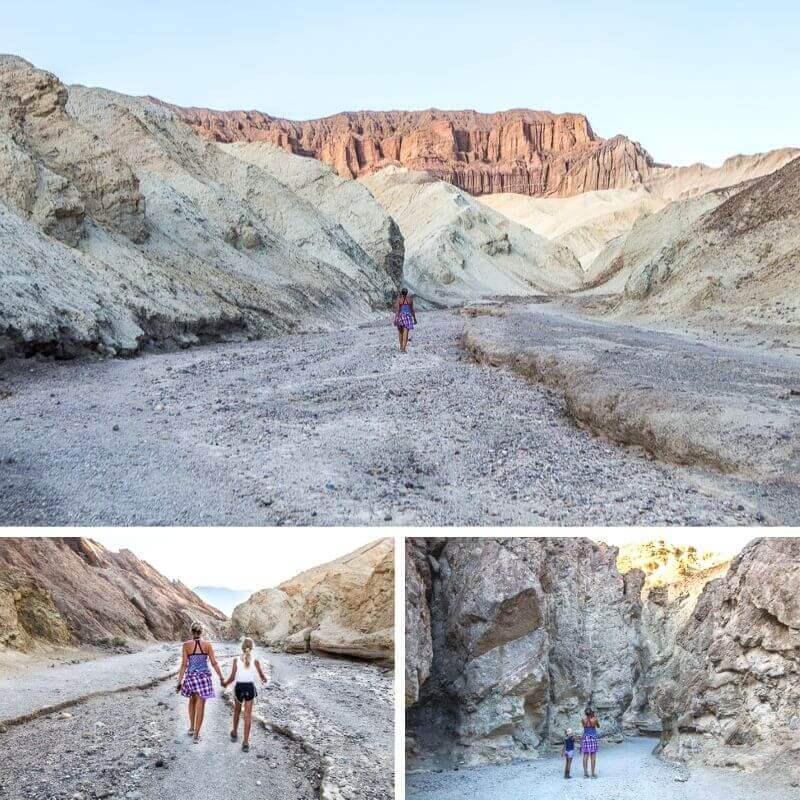
I loved the silence and stillness here and the changing colors and shapes of the rock. It was so quiet you could hear the swooshing of the raven’s wings as it flew down the canyon quite high above our heads. The 1.5 miles in leads to the red cathedral, which is where we were hoping to go.
You can go further and hike 2.5 miles all the way to Zabriskie’s Point, which is on my bucket list for when we come back! I couldn’t imagine how beautiful that walk would be and if you could time it at sunset it would be incredible.
You’d need someone to meet you there or be willing to hike it back. But definitely put this on your Death Valley National Park hiking list!
6. Walk the Salt Creek Trail

I read that the Salt Creek Trail is one of the best trails for families, so decided to check it out, but wasn’t expecting too much. We are quite adventurous and go on many challenging hikes, boardwalks usually feel quite sedate to me, but once again Death Valley wowed me.
The Salt Creek Trailhead is only a mile off the main road and offers proof that the desert is full of life. A creek runs through this valley and either side of it is filled with a green brush. In the background are white and pastel yellow cliffs making it so striking. As far as Death Valley National Park hikes go, the boardwalk is only 1/2 mile in total and is flat and wheelchair accessible.
The kids will love looking at the rare pupfish darting around in the water. They look like tadpoles. Their frenetic rush is their need to feed and breed before their one-year lifespan is up.
7. Wander around the Mesquite Sand Dunes
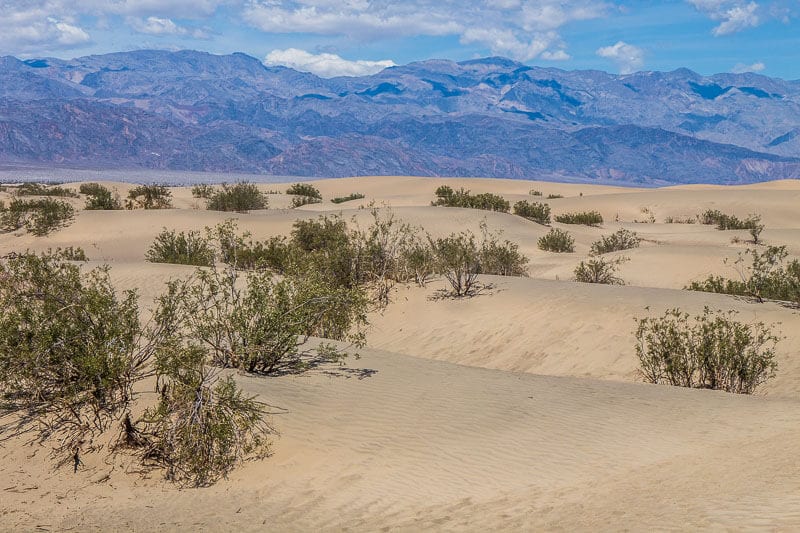
We arrived at the wrong time to experience the Mesquite Flat Sand dunes – we couldn’t time everything perfectly. We visited on the way out of the western entrance to the national park and arrived at the same time as hundreds of French tourists on buses.
No offence to them, as we’re tourists as well wanting the same things they are, but it did mean a lot of people making tracks in the sand. At least you had a nice language to listen to in the background!
It was also the middle of the day so pretty hot and sunlight was harsh for photos and the dunes were well trampled.
You can walk out to the highest sand dune which is a mile away in the distance. A mile is an easy walk on the flat but up and over sand dunes makes it a different kind of trail, especially in the HEAT.
Considering the Death Valley National Park sand dunes were the very last thing we were going to do after 5 months in the desert, we were happy to just stand and watch.
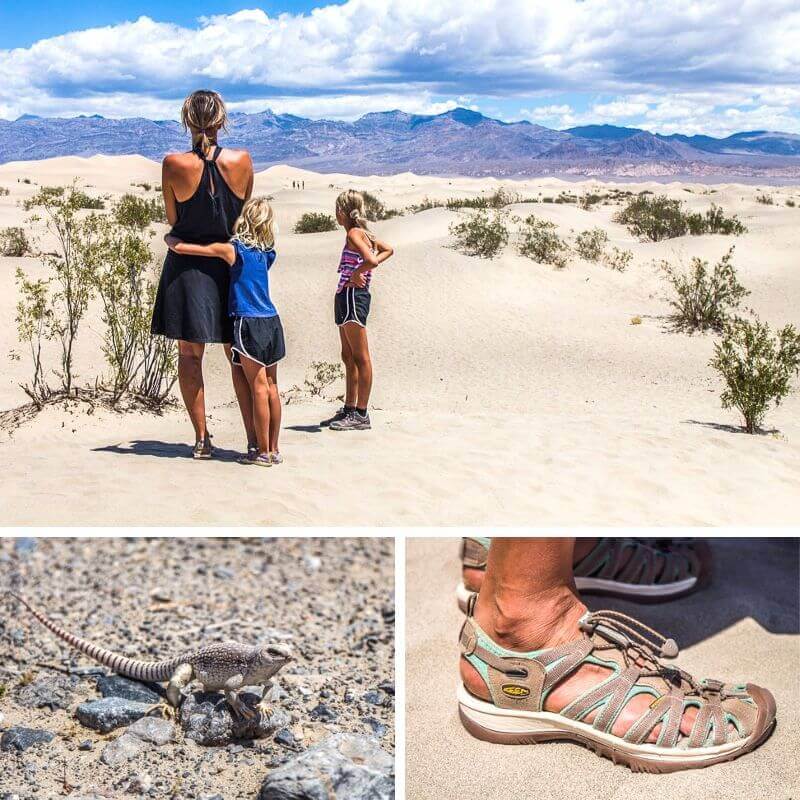
Your kids will love playing in the sand dunes here. The girls were, even more, desert tired than me and were in no mood for sand dune play.
Come early in the morning or evening. Sunset is meant to be wonderful here. I’d time it for then if you can. It’s a fair way from the other Death Valley attractions near the Furnace Creek area so that may impact your timing.
8. Go wildlife spotting in Death Valley
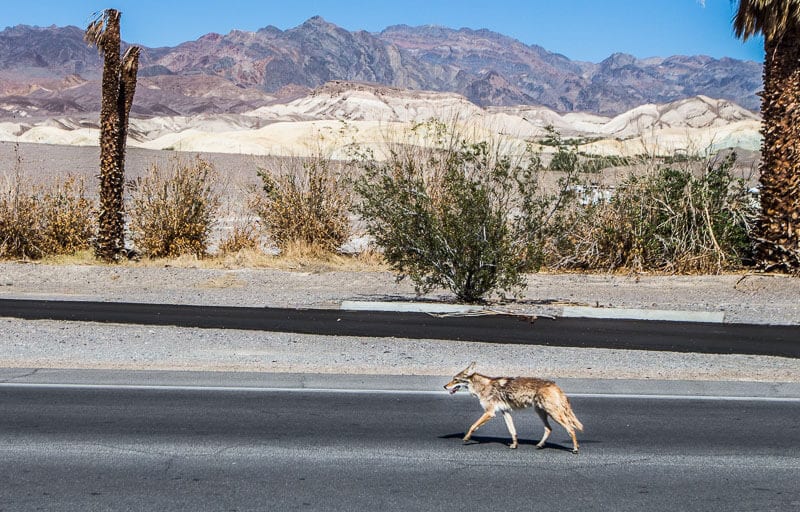
Just because the word DEATH is in the title, doesn’t mean there ain’t no life in this valley. Look closely and you’ll find plenty of animals.
We had a coyote running across the main road (and causing a few traffic delays) just outside our campsite in Furnace Creek. And we also saw a cute and unique chuckwalla lizard at Mesquite sand dunes.
We especially loved seeing this one after learning about it from the ranger when the girls did their Junior Ranger pledge. It gets in between two rocks and puffs up so its predators can’t snatch it away. I LOVE nature! We loved watching it do little push-ups.
One of my favorite things we saw in Death Valley National Park was when a raven came flying above us down the canyon. You will see and hear a lot of ravens swooshing their wings. That is a silence to appreciate.
We also enjoyed seeing the pupfish in Salt Creek. You have to admire something that can survive in all that salty water. Enjoy these little reminders that the desert – even the hottest ones in the world – hold life.
In addition to those desert animals we saw, Death Valley NP also has scorpions, road runners, kit foxes, rattlesnakes, kangaroo rats, and bats.
9. Take the kids to become a Junior Ranger

You probably already know that we love the Junior Ranger program created by the National Park service. It does make a difference to your child’s appreciation of the environment they are interacting in. Not to mention how much they’ll learn.
Head to the Death Valley National Park Visitor Center at Furnace Creek to pick up your booklets and return when finished to say your pledge and get your badges.
As my girls learned more about the desert with the ranger and said their pledge, I felt so grateful a program like this exists to teach our kids to protect Mother Nature.
I have hope for the generation we are raising. They are privy to so much more information, experiences, and people working hard to make changes happen. They grow up knowing that taking care of the planet is just something we do.
10. Admire the Ubehebe Crater

Ubehebe Crater is an incredible sight to see in Death Valley National Park. The crater is over 700 feet deep and almost 0.5 miles in diameter, making it one of the largest in the world. It’s also one of the youngest craters, as it’s estimated to only be 2,100 years old. Though it’s technically an active volcano, the risk of it erupting is very low.
The hike around the crater is fairly easy, making it accessible for most hikers. You can view the crater from the parking lot, but you can walk around the entire rim of the crater, where you’ll find some great spots for photos.
If you’re looking for an amazing day trip in Death Valley National Park, be sure to visit Ubehebe Crater. The sights are incredible, and it’s a great way to explore one of the most stunning areas in the country.
11. Watch the moving stones on Racetrack Playa
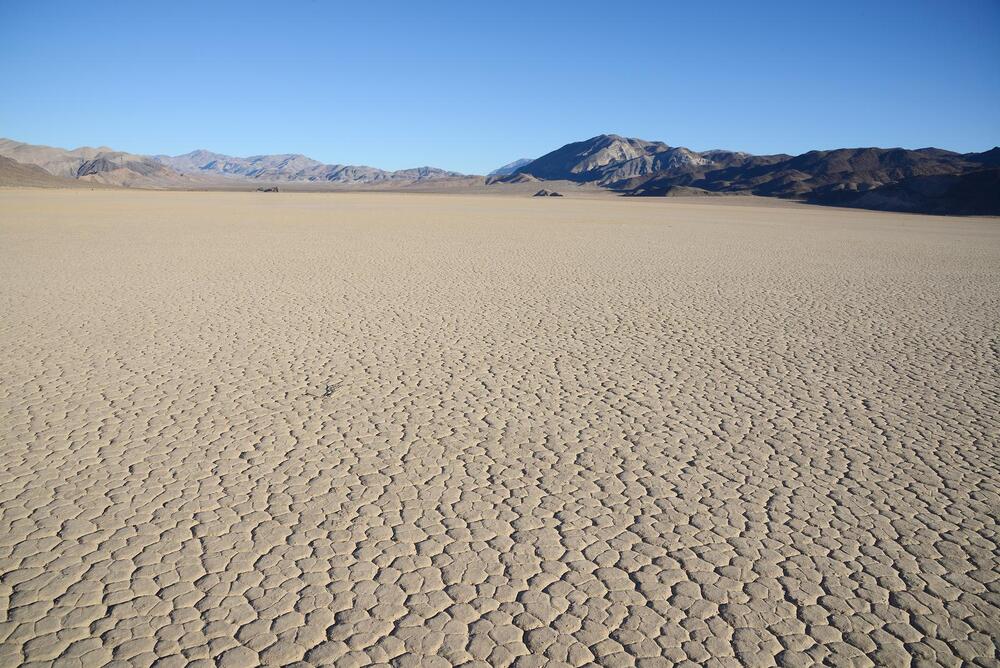
Racetrack Playa is a dry lake bed that is flat and featureless, making it perfect for testing the theory that stones can move across the surface on their own.
The rocks have been observed moving for years, but no one knows how they do it. Some people believe that the wind is responsible, while others think that the rocks are moved by ice particles or water. No one has been able to provide a definitive answer, but it’s still an interesting place to visit.
Though it’s named a racetrack, driving off-road is strictly prohibited. We also don’t recommend driving along here if you have a high clearance vehicle as the road is a bit challenging to drive on.
12. Hike through Mosaic Canyon
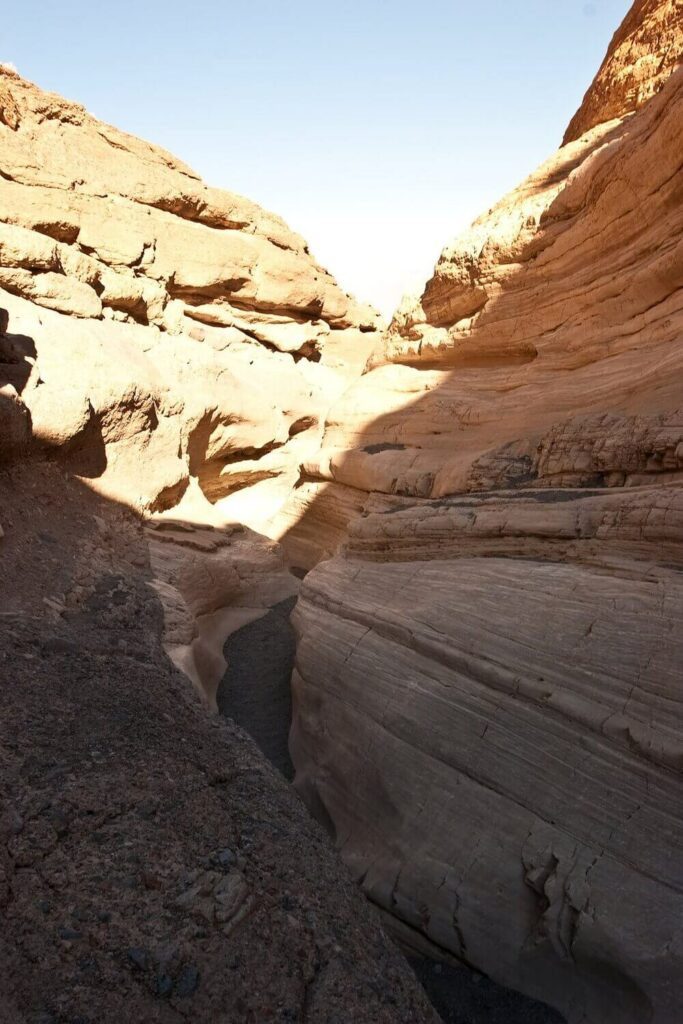
Mosaic Canyon is one of the most beautiful and unique places in Death Valley National Park. The canyon is lined with colorful, vitreous rocks that have been eroded by wind and water over time, creating a spectacular mosaic-like effect.
It’s a great place to explore on foot, as there is a 4 mi (6.4km) out-and-back hiking trail that runs through the middle of the canyon. There are plenty of informative signs along the way to help you learn about the canyon’s history and geology.
The hike is labeled moderate to difficult because after about 2km a big boulder disrupts the path, and only adventurous hikers squeeze between the gaps to get around it.
13. Drive through the Twenty Mule Team Canyon
Twenty Mule Team Canyon is a beautiful and serene place, named for the twenty mule teams that used to transport borax out of the area. The canyon is a great place to drive through on your way to Zabriskie Point.
The canyon, also referred to as the badlands, is known for its colorful and unique rock formations. They have been the setting for many blockbuster movies such as Star Wars Episode VI. If you’re a fan of Star Wars movies, this is a great place to drive through and stop to take photos of you pretending to be a Jedi!
14. Admire Scotty’s Castle
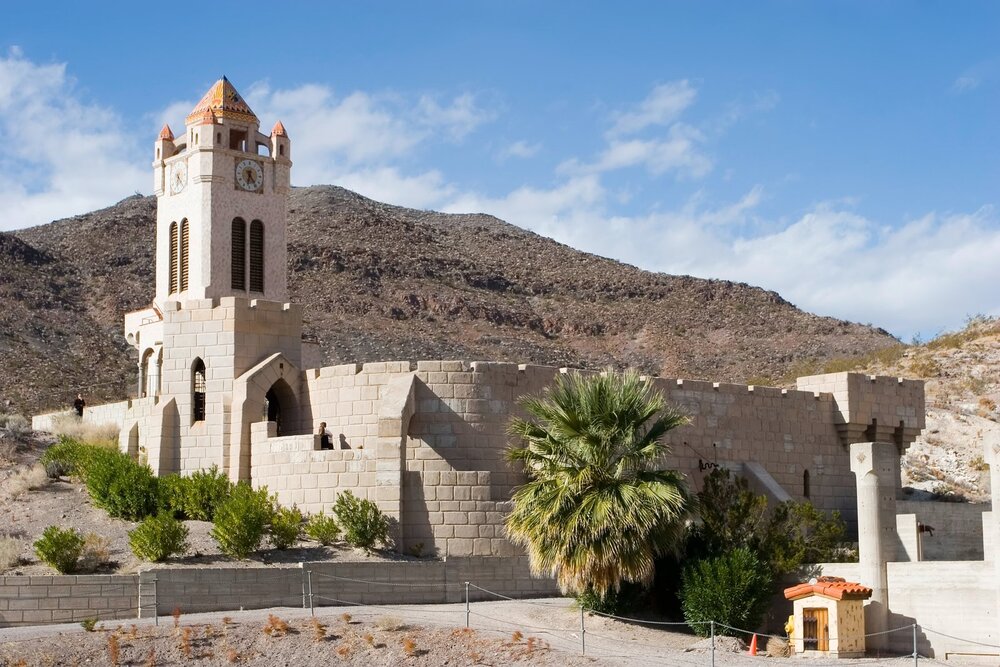
Scotty’s Castle is a Spanish colonial villa was named after gold prospector Walter E. Scott, though he never lived there. Nor is the building actually a castle, more of a mansion with some castle-like features.
It was built in the 1920s by Chicago millionaire Albert Mussey Johnson who was conned into investing in Scott’s gold mine in the Death Valley area. Though the mine turned out to be fraudulent, Johnson and Scott became good friends and so the building was named after him.
The building was built as the vacation home for Johnson and his wife, and they visited several times. But sadly they died without heirs, so the villa was taken over by the National Park Service in 1970.
The castle is a beautiful example of Spanish architecture and is full of intricate details. The grounds are also worth exploring, with gardens, and ponds.
If you’re visiting Death Valley National Park and interested in architecture, it might be interesting to you. It’s amazing to see how someone would want to build such a lavish mansion in this arid landscape.
15. Walk the Darwin Falls Hike
The Darwin Falls hike is a great hike for hikers of all levels. The hike is around 2 miles round trip and is relatively easy, making it a perfect hike for families or beginner hikers.
The trail follows a beautiful stream and shrubbery that leads to the spectacular Darwin Falls. As you hike, you have to cross many streams (yes, that’s right, in the desert there are streams) and pass through plenty of shade. In the Spring, you’ll see wildflowers bloom along the trail, which is certainly the best time to visit.
The waterfall is a great place to take a break and enjoy the beauty of nature. You cannot swim in the falls as they are a source of drinking water in the area. Be sure to bring plenty of water and snacks, as there are no services along the way.
16. Hike to Telescope Peak

For those serious hikers, Telescope Peak is a must-hike in Death Valley. It’s the highest point in the National Park and is even known to have snow at the top!
Telescope Peak is a strenuous hike but offers stunning views of the park’s salt flats, canyons, and mountains. At 11,043ft, this is one of the best places to visit in the park for sunrise since it offers views over most of the park (hence the name, Telescope Peak). You can see as far as Joshua Tree Forest on a clear day.
The peak can be reached by way of two trails: the shorter but more difficult Mosaic Canyon Trail or the longer but less steep Saline Valley Route.
No matter which route you choose, make sure to allow plenty of time to reach the summit, as it can take several hours even for experienced hikers. Once you reach the top, you’ll be rewarded with 360-degree views of this unique and beautiful park.
Important things to know before you go to Death Valley
Before you visit Death Valley, here are some important words of advice and things you need to know.
- Fill up your gas tank before you get there. This is NOT one of the things to do in Death Valley as the gas prices are RIDICULOUSLY expensive. It’s verging on price gouging. At Furnace Creek, it was $6.20 per gallon of diesel fuel. Note that gas in California is way more expensive than anywhere else, but really $6.20?? Apparently, the gas at Stovepipe Wells Village is cheaper, but they don’t have diesel. We found cheaper diesel at Trona when we made it there with 30 miles left in the tank and filled her up. We only put $30 in at the rip-off gas station just to get us out of the park!,
- Death Valley NP gets very HOT. Be sure to drink plenty of water, carry salty snacks, and explore in the cooler morning and evening hours. We recommend Death Valley as a Spring break destination.
- Plan your Death Valley itinerary carefully to avoid excess mileage – see point 1.
- Many of the Death Valley National Park campgrounds close during the summer months!
- Many of the roads to attractions will often be closed due to weather damage. Almost all roads off the main one were closed when we visited, which reduced our off-the-beaten-path adventures but also see point 1.
- In the summer, you can head to the surrounding mountains for a cooler experience. Always check with the rangers to see what is opened and closed.
- Death Valley is a Gold Rated International Dark Sky Park. It was a full moon when we visited so not ideal for star gazing. The best places for stargazing are said to be: Badwater Basin, Mesquite Flat Sand Dunes, and Harmony Borax Works. Just make sure to check whether it will be a clear night sky before visiting.
- We didn’t see any rattlesnakes, but we met someone in Sedona who said they had never seen so many rattlesnakes as in Death Valley. Watch where you put your hands and feet.
- Cell phone service is unreliable. We had limited Wi-Fi throughout the park with Verizon.
- Entrance fees are $30 for 7 days per vehicle. If you plan to visit several national parks in the USA, an annual National Parks Pass is a MUST. It will cost you $80 for the year saving you hundreds of dollars with unlimited access to federal lands without having to pay individual park entrance fees.
- Check the weather forecast before visiting. Death Valley has been known to have flash floods and torrential downpours during the hurricane season in the summer months and early Fall.
Here is another unique and mystical place in California: Mono Lake Tufa State Natural Reserve near Yosemite.
Getting to Death Valley National Park
Death Valley lies mostly in southwestern California, east of the Sierra Nevada, although a small portion extends into Nevada’s Bullfrog Hills. It’s easily accessible from Las Vegas and Los Angeles, though it’s better to go from Lasz Vegas as it’s a 2.5 hour drive, whereas it’s 4.5 hours from LA.
From Las Vegas (approx. 2–2.5 hours), you drive via US-95 North toward Reno, continue for about 85 miles to NV-373 South, turning left toward Death Valley Junction. At Death Valley Junction, turn right onto CA-190 West. Follow CA-190 directly into the park; Furnace Creek Visitor Center is the main hub.
From LA, take the I-15, then take US-395 North, and cut across via CA-190 East for a more scenic mountain approach. The main road transecting Death Valley National Park from east to west is California Highway 190 and makes the journey as beautiful as the destination.
If you don’t have your own vehicle, DiscoverCars.com is a reliable rental car booking service that compares all the major brands like Hertz, Avis, Alamo, and Europcar. For RV Rentals, check RVShare if you want to rent a unique campervan or RV and explore further afield.
How long do you need in Death Valley?
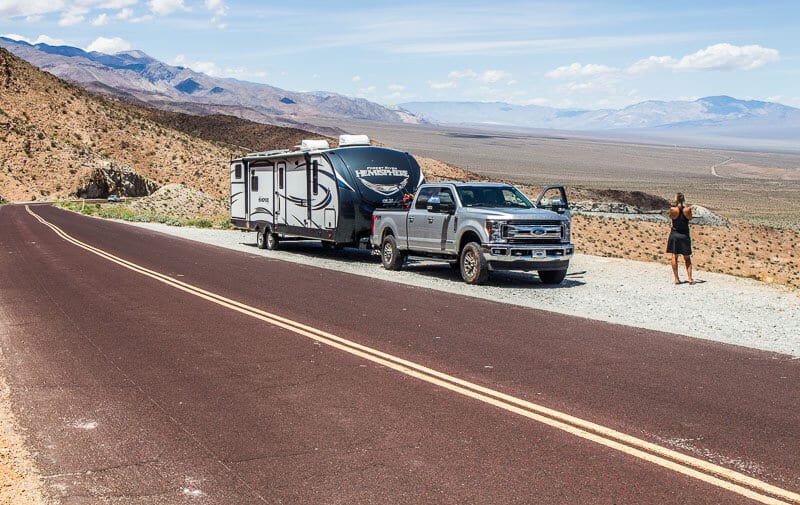
Most people visit Death Valley as a day trip from either Vegas or LA, but we recommend you spend two full days exploring the park. If you’re coming in for the day, then we recommend an early start and late finish and staying overnight nearby. That way you’ll have ample time to do everything at the right times.
Your timing will change depending on the sunset time when you visit, and the direction from where you enter and leave the park from. We arrived from Las Vegas via Hwy 95 in the afternoon and then exited towards Bakersfield via Hwy 190 the next day after lunch.
Is it possible to see Death Valley as a day trip from Las Vegas?
You could visit as a day trip from Vegas, but it would be a very long day and quite rushed. I’d recommend doing it like we did – arrive in the afternoon, stay the night, and leave the next day after lunch.
Here are some other Las Vegas day trip ideas instead.
Where to stay near Death Valley
We recommend staying in Furnace Creek, especially if you are short on time, which is where you will find the Visitor’s Center. It’s closer to the main attractions in Death Valley and it’s situated in a somewhat shady and pretty oasis area. You will get more relief from the heat here.
Stovepipe Wells Village will offer you a more secluded experience and is right near the sand dunes, however, it is pretty much out in the open heat of the desert. In winter it won’t matter too much.
Camping in Death Valley

From my research, you’ll typically be able to find Death Valley National Park camping spots available. However, if you require RV hookups, you’ll want to reserve in advance as they are few and far between.
The National Park has a few campgrounds, and all except Furnace Creek are first come first served.
Furnace Creek Campground is open year-round, but was closed when we visited for some reason. First come first served during summer (mid-April to mid-Oct). Reservations are strongly recommended over winter months.
- Sunset: Closed in summer. Back in sites.
- Texas Springs: Closed summer. First come, first served.
- There is one in Stovepipe Wells: Closed summer.
- Mesquite Spring: open year round.
- Emigrant: tent camping only. Open year-round
- Wildrose: open year round. 25gft limit
- Thorndike: Open March – Nov. 25 ft limit
- Mahogany Flat: open March- Nov. 25 ft length
Get more details about camping in Death Valley here.
Private Campgrounds
- Fiddler’s Campground. Open year round. Fiddlers gives you access to the Oasis at Death Valley swimming pool and showers. You can also use their restaurant facilities. It’s adjacent to the Oasis and the Furnace Creek Visitor Center.
- Stovepipe Wells RV Park – Open all year round. Hookups available.
- Panamint Springs – Open all year. Hookups available and dry camping. It’s at higher elevation so will be cooler. We had friends stay here and recommended it.
There are boondocking spots outside of Death Valley plus a few other RV parks if you get stuck. There is also a cool spot we found on Harvest Host just outside the park.
Hotels in Death Valley

The Oasis at Death Valley is one resort with two distinct Death Valley National Park hotels; the historic, serene, and peaceful Four Diamond Inn at Death Valley, and the family-friendly, adventure-focused Ranch at Death Valley
If I was to stay at hotels in Death Valley, it would be here. I loved its setting on the hill surrounded by desert palms and overlooking the salt flats and furnace creek.
Is Death Valley worth visiting?
Despite its name and reputation, Death Valley is absolutely worth visiting. Its landscape is so varied and unique, with desert on one side and mountains on the other. It also has a salt basin and a volcanic crater, as well as a strange natural phenomenon that causes the rocks to move with no gravitational cause – spooky!
We didn’t know there were so many incredible things to do in Death Valley National Park until after our two-day visit. Now we know this is not just a place you drive through on your way to other California destinations!
Places to visit near Death Valley
Looking for more places to visit in the USA near Death Valley? Start with these posts:
More National Parks in the USA
Are you planning to visit more national parks in the USA? Then you might find these guides useful!
I hope this guide to things to do in Death Valley National Park helps you plan your trip. If you still have any questions about what to see in Death Valley, leave a comment below.
